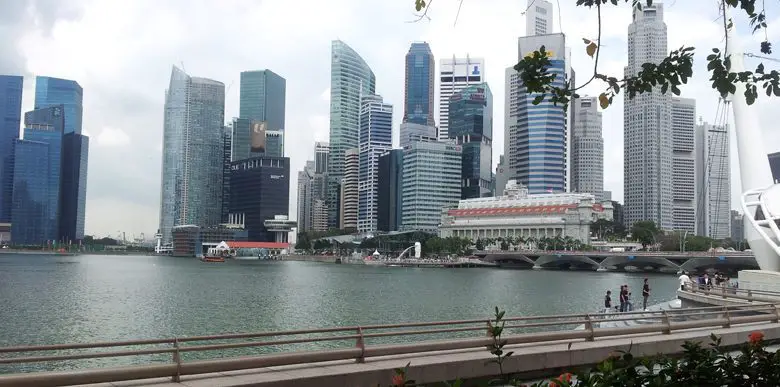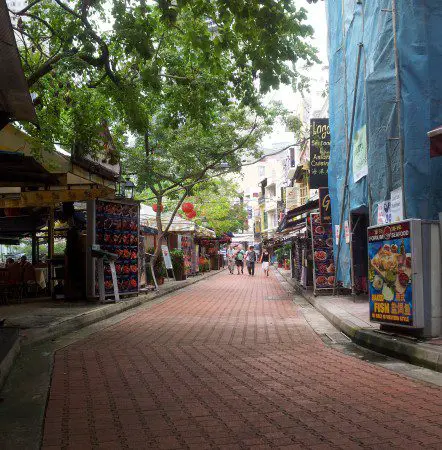
Wheelchair disasters and triumph on the far side of the world…
It is Tuesday 13th March and I write this post from a café in my hotel in Sydney. As you may already be aware, both Martyn and I are abroad during the month of March, Martyn volunteering in Spain, and me in Sydney (via Singapore for a wedding).
I originally intended to write this article mainly to share some thoughts about accessible travel in Singapore, but instead am filled with a certain sense of glumness at the events of the last 24 hours that I think serves as a timely reminder of how triumph and disaster can sit so close together. On arriving in Sydney, I was immediately greeted by a member of staff from Singapore Airlines (SQ)… who informed me that my wheelchair had been damaged.
The natural optimist in me was clinging on to the hope that the damage was superficial or easily repairable. However, my heart sank as I saw the twisted and mangled piece of metal that once represented the right wheel of my Balder F290.
The SQ staff tried desperately to see if they could fix it, or least patch it up enough so that I could get to my hotel, but we quickly realised that the damage needed professional input. While we (me, my PA and a friend) waited for the repairman’s verdict, the SQ staff were very friendly, and did genuinely feel sorry about the situation, trying whatever they could to help 3 weary, jetlagged, hungry and thirsty travellers that had been on a plane for over 8 hours. Alas, the damage was too great for the wheelchair to be fixed on site and needed to be taken to a workshop. To get me to the hotel, SQ also managed to source a very basic power wheelchair in the middle of the night that could get me to a taxi.
So here I am, about 16 hours later, sitting in a very uncomfortable wheelchair that can’t really manage the outdoors. An incorrectly fitting wheelchair also means that I struggle to feed myself and move my arms. I still don’t know if, and when, my wheelchair can be repaired and, even if it can be patched up, it is unlikely that I will be able to use it to my usual level of independence given the structural damage that it has received. I sit here wondering if my dream holiday (for which I spent an age saving up for) will be spent trapped in a hotel.
Enough with the dreariness though, and as the title of this post states, disaster sat right next to triumph. In this case, the triumph was Singapore and watching two very dear friends getting married in a beautiful ceremony surrounded by their loved ones.
Singapore is a fantastic and exciting place. It is a vibrant melting pot of distinct cultures that fuse together to create a dynamic city that has influence as a regional and global centre for trade and commerce, which will undoubtedly increase in the years to come.
The glitzy lights of the Orchard Road, the thronging bars of Boat Quay and the packed Hawker Centre serving all kinds of Asian cuisine are constant (albeit rather shallow and superficial) reminders of the fact that this is a place that simply has not experienced a recession of any kind.
The result of this is that much of the infrastructure is very modern and very accessible. Singapore is the first city I have been to where, as a wheelchair user, I was able to use every metro (known as the MRT in Singapore) station. The ability to use public transport like any other member of the public was a very empowering experience that I had never felt before. The recentness of its infrastructure also means that the majority of shops and restaurants in the city centre are also wheelchair accessible.
While Singapore has many things going for it in terms of accessibility, there are a couple of things that any disabled traveller using a wheelchair would need to be aware.
Firstly, crossing the road can sometimes be a nightmare! The busiest interchanges do not have pedestrian crossings, but instead have underpasses that were built a while ago and so do not have lifts. In order to cross such roads in an accessible manner, one must enter the labyrinth of gigantic shopping malls that exist in a kind of underground city that lies beneath the Singaporean surface. Finding the correct series of lifts that connect the different underground levels to a route where you can cross the road can take ages as the signposting is just awful. To make things worse, once the shopping malls close at around 11pm, many of the undergrounds routes close as well, meaning that you have to take very long detours at surface level to find a pedestrian crossing.
Secondly, accessible taxis (London-style taxis provided by SMRT) are expensive, in short supply and need to be booked well in advance. Even though the MRT is brilliant, it closes between 11.30 and midnight meaning that it can be difficult to enjoy Singaporean nightlife in places beyond walking distance from your hotel. Also, as a result of this taxi problem, it can be difficult to get to places on the edge of the city that do not have MRT stations in close proximity.
Therefore, if any wheelchair user reading this article is planning to visit Singapore and wants to enjoy the nightlife, I would strongly recommend staying in the area near Marina Bay (pictured at top) or the Orchard Road. I stayed at the Marina Mandarin Singapore, which was by the Marina Bay and had an accessible room that was spacious.
When I return to the UK, I will write another post about some of the other sights and sounds of Singapore and more about going to a traditional Hindu wedding, but the time remaining on my internet café card is decreasing and the backache I have sitting in this bucket of a replacement wheelchair means it is time to lie down and watch some Australian daytime TV.
I am determined to not let this episode in Sydney put me off travelling. Triumph and disaster have to be treated as the imposters that they are and I am already feeling slightly less glum than when I began writing. I will do what I can to make this most of this trip! I also really hope that something can come out of this in terms of working with airlines to help improve the process of transporting a wheelchair.
All the best from Sydney, Australia!
By Srin Madipalli

srinu,
very sad that you have to go all through in a alien land without any product support. That’s the reason with pratyush’s wheel chair i insist that it should not be booked and handedover after he sits in the aircraft. But! his is a manual one and we have experienced even with a calf support lost once he felt awful.
I think you are having to be in the sydney hotel or by now your wheel chair is fixed.
all the best..
Firstly, I want to say how great it is that you are writing to inform us of all the difficulties that can arise when travelling abroad.We have an eight year old son with a rare form of sma and we are very keen for him to see our great world! We also travel with his 12 year old autistic brother, which also can bring us big challenges ! We would like to take the boys to Singapore after travelling there some 13 years ago and having an amazing trip.We finally ventured to Brisbane last year to see family, we travelled with Cathay pacific who excelled in looking after us all.We decided to take only a manual chair as we had heard horrendous stories of airline breakages in the hold.Our only problem arose was when we arrived back at Heathrow after our o
Long flight to be told that they had lost the wheelchair! Only in the uk could that happen ! After a lengthy wait, with still no chair and no airport chair to take my son to the baggage area my husband had to carry my son, until they finally found it ! It makes you so pleased to be home ! Keep writing as Iam always keen to see what adventures are possible for my boys !